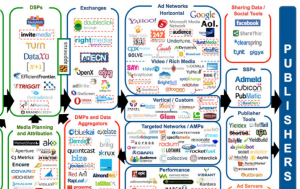This is the fourth in a series of posts walking readers through the mobile advertising space. Stay tuned for at least one more post in the coming weeks. This post is also published on the Rubicon Project blog.

Fixing Mobile
When evaluating advertising options on mobile devices, it is important to consider the screen size as well as whether the content is viewed in mobile web or a native mobile application. Content that is viewed in a browser is often suboptimal for advertising. When presented with a standard un-optimized web page the phone’s browser will shrink the content to fit the width of the display. This has the unfortunate side effect of also shrinking ads, often until they’re very small. In this scenario, advertisers are not getting their money’s worth, as their ads are often too small to see.
Advertising Banners
To successfully advertise on web pages displayed on a mobile phone a site’s layout must be mobile optimized. This single column of content optimized for a phone’s screen lends itself to an advertising unit that spans the screen unobstructed. While hardly anyone would think that these small banner units that span the screen are the answer to mobile advertising needs, this is at least a place to start.
In an attempt to expand the advertising opportunities on mobile, the IAB is working with advertisers and publishers to create new, more engaging ad units for mobile. These units have names like “Push” and “Slider”. They are initially inconspicuous on the page, but can take over the entire screen to create a more immersive experience. Adhesion banners stay in the same place on the screen, remaining in view throughout the user’s session. Creative thinking like this has led to ad units that expand to the limits of the screen of the device. Rather than being little boxes on the screen, these ad units use the full dimensions of the device to be more immersive and engaging.
App Environment
Content viewed in mobile apps have distinct challenges from their web counterparts. These challenges are common to phones and tablets. The most prominent challenge is the requirement of the SDK (or Software Development Kit). SDKs are sets of code that an application developer integrates into their app to allow mobile ads to run within their app. Mobile inventory buyers, generally, develop SDKs. Their code enables the application to call the buyer’s ad server to get ads and render them properly. For each demand source that the application developer partners with, there is likely a new SDK integration. The problem is that all these SDKs have a distinct set of instructions to perform a fairly common set of tasks. The proliferation of distinct SDKs has resulted in more fragmentation in the market.
There are still stories of app developers integrating up to seven different SDKs to manage the need for competitive demand for inventory. Managing multiple SDKs can be problematic. There is non-trivial operational and technical overhead of integrating additional code to the application. Demand partners have their own development roadmaps and update their SDKs on their schedule. Each time an SDK is updated the application developer needs to re-integrate the code and re-submit the app for approval to iTunes or Google Play.
It’s not all gloom and doom in the app world though. The IAB has recently made efforts to normalize the SDK interactions to reduce the learning curve for integrating different SDKs. It introduced the Mobile Rich Media Ad Interface Definitions, or MRAID. MRAID is an effort to create a common set of standards. Indeed, many mobile advertising companies now offer MRAID compliant creatives. As support for MRAID grows we all can be hopeful that these woes will subside.
Through the use of SDKs, mobile apps are able to make use of functionality that is native to mobile devices to deliver a more engaging advertising experience. Companies such as InMobi or Celtra offer a rich advertising experience to the user instead of the standard still-image ad (with click-through) that is very prominent in online display advertising. The SDK opens the door for highly interactive and engaging ads, which have actually been well received by users.
Tablets
Tablet inventory, whether accessed through an app or web, comes with some interesting opportunities. First among them is the larger screen offering the potential for larger ad formats. There are several tablet-specific formats gaining traction in the market. Some are custom for a specific application. Others, like the Filmstrip from IAB’s rising stars, are approaching a level of standardization that can be leveraged by application developers and the currently rare tablet-optimized web.
The impact of these challenges depends on the user experience that you design for your mobile users. You should decide what the appropriate experience is for your content type, and then deal with the relevant advertising issues that arise. Formatting and building content specifically for mobile is the first step toward monetizing content. Have you had issues integrating SDKs with your mobile apps?








